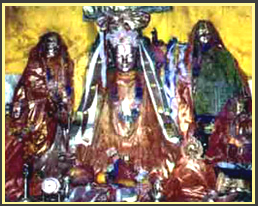 |
 |
Thiru Salagramam |
| Home |
|
| History - Thiru Salagramam |
| Muktinath is a pilgrimage
shrine located 140 miles from Kathmandu in the snow clad Himalayas.
It is located near the Gandaki river famous for the Salagrama stones.
River Gandaki is also known as Narayani or Salagrami. Muktinath
is also one of the 51 Sakthi Peethams of India. About 16 miles from
Muktinath is the Damodara Kundam, the source of this river. The
Salagrama stones held in worship are found in this part of Nepal. a) Jwalamukhi From Muktinath, Damodar kund is around 2 days trekking
, but there are no food available on the way and one has to go prepared. Theertham - Chakra Theertham, Kandaki river. |
 |
 |
| Mangalasasanam: |
Thirumangaialwar -
988-997 Total of 12 Paasurams. |
| Special Information | |
| Dieties | Sri Moorthy, Sri Devi Nachiyar |
| Vimanam | Kanaka Vimanam |
| Theerthangal | Chakra Theertham, Kandaki River |
| Mangalasasanam | Thirumangaiazhwar |
| Prathyaksham | Brahma, Rudra |
| Direction and Posture | North-faced and Standing Posture |
| Travel Base | Katmandu |
| Accessibility | Located within Nepal. Nepal Government Permit
required.110 miles from Nepal State Railway Station(Amlagunj). Very
cold and snow-bound region. |
| Moolavar |
| The Moolavar of this Salagrama sthalam is Sri Moorthy Perumal. He is found in Nindra thirukkolam facing his thirumugham along North direction. Prathyaksham for Brahma devan, Rudran and Kandaki. |
| How to Get There. |
Muktinath is a pilgrimage
shrine located 140 kms from Kathmandu in the snow clad Himalayas
and it is located near the Kandaki river famous for the Salagrama
stones. Muktinath is also one of the 51 Sakthi Peetams of India.
There is lots of doubt, where this Divyadesam is located. Some says
that Mukthinath, which is found 170 kms from Katmandu, it is said
the Salagrama Kshetram which is found on the banks of Kandaki river.
Mukthinath is otherwise called as "Mukthi Narayanan kshetram".
But, some say, about 65 kms away from Katmandu, there is a place by named "Damodhara Kund", which is found on the bank of Kandaki river is said to be the Salagrama sthalam. But, whatever it might be, we all the bhaktas should consider that the stones (the Salagramam) which is found on the bank of Kandaki river is said to be considered as the Salagrama sthalam |